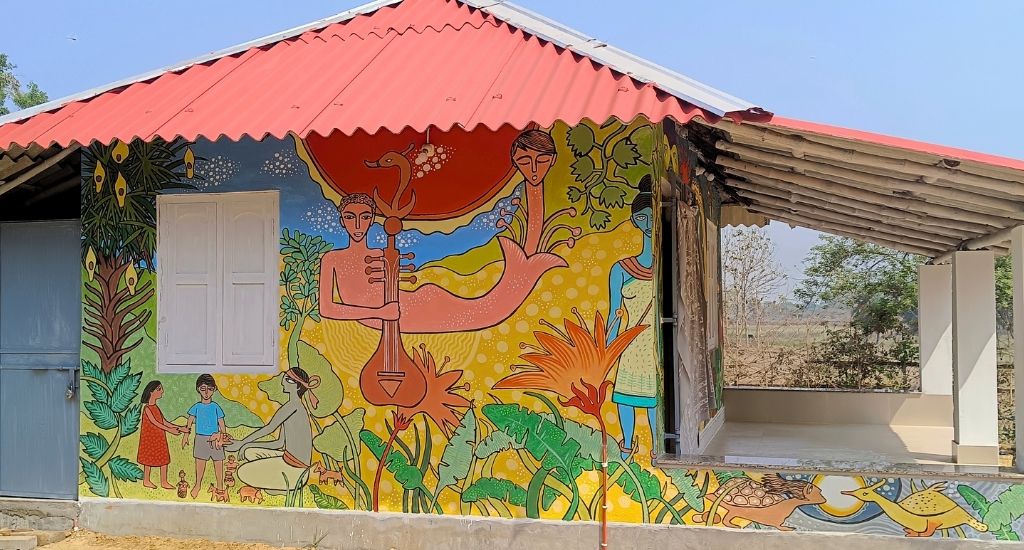
FTLO art, visit this West Bengal village
Country folks from a rugged, tree-lined rural corner of West Bengal that only a handful had ever heard of have transformed their village into one giant art project.

Country folks from a rugged, tree-lined rural corner of West Bengal that only a handful had ever heard of have transformed their village into one giant art project.
Tucked away in the deep woods of Jungle Mahals, about 180 km west of Kolkata, the sleepy hamlet of Khoabgaon is living its dream, or “khoab”.
This tiny but big-hearted “village of dreams” of the Lodha tribe has quietly painted out its sepia-toned existence with a blast of vivid colours.
Every house has outdoor murals that feature scenes from the Ramayana and Mahabharata, ordinary people going about their daily lives, or paintings portraying assorted subjects such as animals, plants, flowers, and game hunting.
Also Read | Odisha village continues to keep traditional art alive

The artwork reflects a rustic tone and tenor that compliments a meld of Indian classical art forms like Bhil, Kalighat and Madhubani that are done in bright, natural colours and in a simple style.
The murals have now become a background fixture for tourist photos.
“We are happy when people come and take selfies with us,” said Jaba Ahir, 32, a homemaker.
The murals draw viewers from the cities to this farming community of only 13 households with around 85 people. For first-time visitors, there’s one word to describe the experience: gobsmacked.

But how did rock-solid peasants, their children and their wise and retired, pick up the paintbrush to turn an uneventful village into one huge visual arts gallery? The answer can be traced back to 2018 when artist Mrinal Mandal of Kolkata swung by the village and found himself, what else but, gobsmacked by its scenic charms.
“I was enthralled by the beauty of the village set deep inside a forest rich in biodiversity. I immediately decided to transform it into an art village,” said Mandal, who is from Jhargram, a township about 5km away.
The idea was to transform the outer walls of every house into a canvas for artists to unleash their unbounded imagination. And therein rested the challenge because the hardy people living single-storey mud cottages with tiled, thatched or tin roofs were far removed from the world of art.
Also Read | Bayalu Chitralaya: Karnataka village eyes reclaiming artistic past
“We were living a simple life, farming for our livelihood, tending our livestock. We didn’t know anything about painting,” said villager Kamal Mahato, 55. A daub of dried paint on his hands tells he’s been plying the paintbrush too.

To begin with, Mandal sounded out his artist buddies and they all came rushing, drawn by the novelty of the project.
“Soon we began drawing murals on the walls of the mud houses. The villagers were a bit sceptical in the beginning, but didn’t stop us. They thought their village would now get much-needed attention,” he said.
Mandal and fellow artists started art classes that very year for people of all ages, children and adults alike. They explained how the villagers could look forward to an economic revival through art. Learning was slow, but hands that wield the axe, plough or machete for a living are steady.
Rameshwar Soren, one of the first teachers, said the children were initially reluctant, but their interest in visual arts stirred slowly and some became experts in drawing murals.

“As time went by, we also got students from neighbouring villages.” The children wipe out old murals every year during Kali Puja and draw fresh frescos.
The transformation was complete when renowned artist Sibaji Bandyopadhyay visited the village and renamed it as Khoabgaon. The place was known before as Lalbazar—not to be confused with the police headquarters by the same name in Kolkata.
Artisans from Bankura district, known for its terracotta and metal craftsmanship, poured in too. They taught the villagers the ancient art of making Dokra, or Dhokra, figurines that fetch good money in the art and handicraft market.

Named after the nomadic Dhokra tribe, the art involves non–ferrous metal casting using wax—a technique that has been around in India for over 4,000 years and still used. One of the earliest known lost wax artefacts is the dancing girl of Mohenjo-daro.
Villagers have been also trained in Katum Kutum, the craft of making objects d’art from tree barks, twigs, roots and trunks by retaining their natural shape and form.
Also Read | Saving Khovar and Sohrai arts of “painted villages”
“Our products are sold in the cities now. Tourists also buy when they visit. Our income has increased. But not many people know about our village. Publicity through social media will help us,” said Kajal Mallick, 45.
Residents are unhappy with a wall being built by the government that has blocked the entryway to the village. Officials assured that the matter has been looked into.
But Mallick isn’t convinced. “A single road leads to our village. We would be trapped here if that’s blocked. We have complained several times to the local administration, but to no avail.”

Before the murals, living standards were low and the residents cash-strapped. Now, they hope the art project will attract more tourists.
“We have created a model village and it needs continuous funding to sustain it. The government should help,” said Mallick.
The lead image at the top shows the beautiful craft on the walls of Khoabgaon village (Photo by Gurvinder Singh)
Gurvinder Singh is a journalist based in Kolkata.